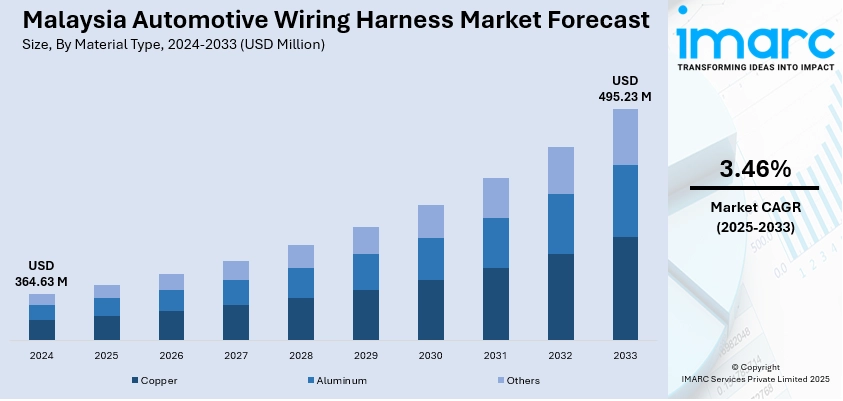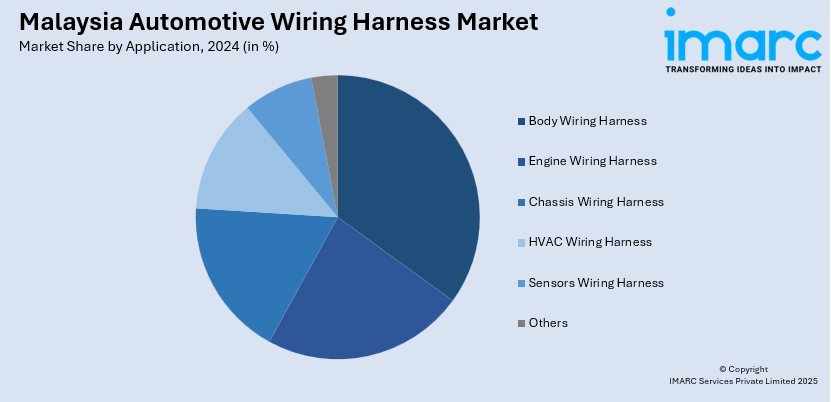
Malaysia Automotive Wiring Harness Market Size, Share, Trends and Forecast by Application, Material Type, Transmission Type, Vehicle Type, Category, Component, and Region, 2025-2033
Malaysia Automotive Wiring Harness Market Overview:
The Malaysia automotive wiring harness market size reached USD 364.63 Million in 2024. Looking forward, the market is expected to reach USD 495.23 Million by 2033, exhibiting a growth rate (CAGR) of 3.46% during 2025-2033. The demand is driven by rising vehicle assembly output, EV and hybrid investment by global OEMs, and regional export orientation. Government-backed clusters and ASEAN trade policies enhance supply‑chain development. The Malaysia automotive wiring harness market share is further enhanced by regional integration and local production incentives.
|
Report Attribute
|
Key Statistics
|
|---|---|
|
Base Year
|
2024
|
|
Forecast Years
|
2025-2033
|
|
Historical Years
|
2019-2024
|
| Market Size in 2024 | USD 364.63 Million |
| Market Forecast in 2033 | USD 495.23 Million |
| Market Growth Rate 2025-2033 | 3.46% |
Malaysia Automotive Wiring Harness Market Trends:
Advancement Towards Smart Manufacturing
Malaysia’s automotive wire harness market is rapidly evolving, driven by the country’s push towards Industry 4.0 and smart factory initiatives. Leading players like J.K. Wire Harness Sdn. Bhd. are investing in digital transformation in 2025, integrating Industrial Internet of Things (IIoT), automation, and data-driven processes to enhance efficiency, product quality, and competitiveness. Supported by government bodies such as MIDA and MARii, the industry is focusing on robotics, real-time monitoring, and predictive maintenance technologies. These advancements aim to meet growing demand for high-performance wiring solutions in electric and connected vehicles. As global OEMs prioritize supply chain resilience and smart capabilities, Malaysia is positioning itself as a hub for advanced automotive manufacturing in Southeast Asia.

To get more information on this market, Request Sample
Emergence of Eco‑Materials and Recycling Practices
Sustainability initiatives are gradually shaping harness production in Malaysia. Suppliers are piloting recycled polymer materials and waste-reduction efforts within fabrication facilities. Reclaiming production scrap for reuse and exploring bio‑based insulation materials reflect efforts toward circularity. Certification programs such as ISO 14001 are increasingly adopted to support environmental governance. Material traceability frameworks are under development to document lifecycle impact and supplier compliance. Although at an early stage, these measures signal growing alignment with OEM and regional ESG expectations. Over time, eco-certified materials and sustainable process protocols are expected to influence supplier selection and design decisions within Malaysia automotive wiring harness market growth. For instance, in May 2024, Yazaki and Toray Industries created a recycled polybutylene terephthalate (PBT) resin specifically for automotive wiring harness connectors. Produced from manufacturing scrap, this resin reduces carbon emissions while delivering performance equivalent to virgin materials. Their partnership focuses on promoting a carbon-neutral and circular economy within the automotive sector.
Malaysia Automotive Wiring Harness Market Segmentation:
IMARC Group provides an analysis of the key trends in each segment of the market, along with forecasts at the country/regional level for 2025-2033. Our report has categorized the market based on application, material type, transmission type, vehicle type, category, and component.
Application Insights:

- Body Wiring Harness
- Engine Wiring Harness
- Chassis Wiring Harness
- HVAC Wiring Harness
- Sensors Wiring Harness
- Others
The report has provided a detailed breakup and analysis of the market based on the application. This includes body wiring harness, engine wiring harness, chassis wiring harness, HVAC wiring harness, sensors wiring harness, and others.
Material Type Insights:
- Copper
- Aluminum
- Others
A detailed breakup and analysis of the market based on the material type have also been provided in the report. This includes copper, aluminum, and others.
Transmission Type Insights:
- Data Transmission
- Electrical Wiring
The report has provided a detailed breakup and analysis of the market based on the transmission type. This includes data transmission and electrical wiring.
Vehicle Type Insights:
- Two Wheelers
- Passenger Cars
- Commercial Vehicles
A detailed breakup and analysis of the market based on the vehicle type has also been provided in the report. This includes two wheelers, passenger cars, and commercial vehicles.
Category Insights:
- General Wires
- Heat Resistant Wires
- Shielded Wires
- Tubed Wires
The report has provided a detailed breakup and analysis of the market based on the category. This includes general wires, heat resistant wires, shielded wires, and tubed wires.
Component Insights:
- Connectors
- Wires
- Terminals
- Others
A detailed breakup and analysis of the market based on the component have also been provided in the report. This includes connectors, wires, terminals, and others.
Regional Insights:
- Selangor
- W.P. Kuala Lumpur
- Johor
- Sarawak
- Others
The report has also provided a comprehensive analysis of all the major regional markets, which include Selangor, W.P. Kuala Lumpur, Johor, Sarawak, and others.
Competitive Landscape:
The market research report has also provided a comprehensive analysis of the competitive landscape. Competitive analysis such as market structure, key player positioning, top winning strategies, competitive dashboard, and company evaluation quadrant has been covered in the report. Also, detailed profiles of all major companies have been provided.
Malaysia Automotive Wiring Harness Market News:
- In February 2025, Lear Corporation completed the acquisition of StoneShield Engineering, an automation-focused company based in Portugal that specializes in wire harness solutions. StoneShield’s capabilities include robotics, automated taping, and high-voltage harness assembly. This acquisition enhances Lear’s E-Systems division and aligns with its IDEA strategy, which aims to modernize manufacturing through the adoption of digital and automated technologies.
Malaysia Automotive Wiring Harness Market Report Coverage:
| Report Features | Details |
|---|---|
| Base Year of the Analysis | 2024 |
| Historical Period | 2019-2024 |
| Forecast Period | 2025-2033 |
| Units | Million USD |
| Scope of the Report |
Exploration of Historical Trends and Market Outlook, Industry Catalysts and Challenges, Segment-Wise Historical and Future Market Assessment:
|
| Applications Covered | Body Wiring Harness, Engine Wiring Harness, Chassis Wiring Harness, HVAC Wiring Harness, Sensors Wiring Harness, Others |
| Material Types Covered | Copper, Aluminum, Others |
| Transmission Types Covered | Data Transmission, Electrical Wiring |
| Vehicle Types Covered | Two Wheelers, Passenger Cars, Commercial Vehicles |
| Categories Covered | General Wires, Heat Resistant Wires, Shielded Wires, Tubed Wires |
| Components Covered | Connectors, Wires, Terminals, Others |
| Regions Covered | Selangor, W.P. Kuala Lumpur, Johor, Sarawak, Others |
| Customization Scope | 10% Free Customization |
| Post-Sale Analyst Support | 10-12 Weeks |
| Delivery Format | PDF and Excel through Email (We can also provide the editable version of the report in PPT/Word format on special request) |
Key Questions Answered in This Report:
- How has the Malaysia automotive wiring harness market performed so far and how will it perform in the coming years?
- What is the breakup of the Malaysia automotive wiring harness market on the basis of application?
- What is the breakup of the Malaysia automotive wiring harness market on the basis of material type?
- What is the breakup of the Malaysia automotive wiring harness market on the basis of transmission type?
- What is the breakup of the Malaysia automotive wiring harness market on the basis of vehicle type?
- What is the breakup of the Malaysia automotive wiring harness market on the basis of category?
- What is the breakup of the Malaysia automotive wiring harness market on the basis of component?
- What is the breakup of the Malaysia automotive wiring harness market on the basis of region?
- What are the various stages in the value chain of the Malaysia automotive wiring harness market?
- What are the key driving factors and challenges in the Malaysia automotive wiring harness market?
- What is the structure of the Malaysia automotive wiring harness market and who are the key players?
- What is the degree of competition in the Malaysia automotive wiring harness market?
Key Benefits for Stakeholders:
- IMARC’s industry report offers a comprehensive quantitative analysis of various market segments, historical and current market trends, market forecasts, and dynamics of the Malaysia automotive wiring harness market from 2019-2033.
- The research report provides the latest information on the market drivers, challenges, and opportunities in the Malaysia automotive wiring harness market.
- Porter's five forces analysis assist stakeholders in assessing the impact of new entrants, competitive rivalry, supplier power, buyer power, and the threat of substitution. It helps stakeholders to analyze the level of competition within the Malaysia automotive wiring harness industry and its attractiveness.
- Competitive landscape allows stakeholders to understand their competitive environment and provides an insight into the current positions of key players in the market.
Need more help?
- Speak to our experienced analysts for insights on the current market scenarios.
- Include additional segments and countries to customize the report as per your requirement.
- Gain an unparalleled competitive advantage in your domain by understanding how to utilize the report and positively impacting your operations and revenue.
- For further assistance, please connect with our analysts.
 Request Customization
Request Customization
 Speak to an Analyst
Speak to an Analyst
 Request Brochure
Request Brochure
 Inquire Before Buying
Inquire Before Buying




.webp)




.webp)












